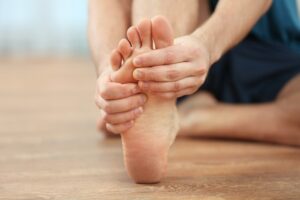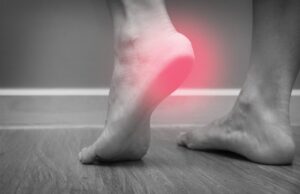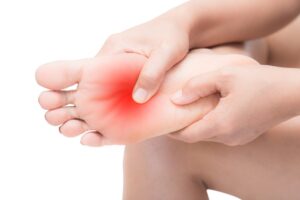
We’ve all had sore feet after a long day of standing or walking, but it’s only when you feel foot pain that you realize exactly how important the appendage is. Your feet act as shock absorbers, and every time you take a step, there is pressure placed on them. While mild pain is common, with as many as 77% of adults experiencing consequences from foot pain, more severe or prolonged issues are not. Understanding how your feet work and why they are critical can help you to determine when foot pain is a cause to visit professionals like orthopedic doctors.
Anatomy of Your Foot
Even though they are a small part of your body, the feet are very complex. They contain 26 bones, 30 joints, and almost 100 muscles and ligaments. Each part plays a crucial role in your ability to stand upright, balance, and walk. Damage to any small part of your foot may result in severe pain or the inability to perform normal daily activities.
Your foot can be divided into three general sections: the forefoot, midfoot, and hindfoot. The forefoot is the front part of your foot, including your toes and the balls of your feet. The midfoot contains the arch of your foot, while the hindfoot is primarily your heel.
Common Causes of Foot Pain
The bottoms of your feet may hurt for a range of reasons. Some of the most common are listed here, though a diagnosis and foot pain treatment should only be made through an orthopedic doctor.
Plantar Fasciitis
 One of the most common causes of foot pain is plantar fasciitis, a condition in which the arch of your foot becomes inflamed. The inflammation can result in sharp, stabbing pain in the heels and the sole of your foot. This is often most severe in the morning or after a prolonged period of rest, with the pain dulling the more that you walk. Stretches and ice or heat therapy can also help dull the pain.
One of the most common causes of foot pain is plantar fasciitis, a condition in which the arch of your foot becomes inflamed. The inflammation can result in sharp, stabbing pain in the heels and the sole of your foot. This is often most severe in the morning or after a prolonged period of rest, with the pain dulling the more that you walk. Stretches and ice or heat therapy can also help dull the pain.
Risk factors for plantar fasciitis include wearing shoes with poor arch support, walking barefoot, or standing and walking on hard surfaces.
Metatarsalgia
This condition, caused by high-impact activities like running and jumping, causes pain and inflammation in the ball of your foot, at the base of your toes. The stress on the bottom of the feet from certain activities can cause this, and as many as 80% of people have experience metatarsalgia at least once. Rest and orthopedic shoe inserts are usually enough to alleviate symptoms.
Peripheral Neuropathy
 For many people, the nervous system can be the root of foot pain. Neuropathy, which refers to nerve pain, is considered peripheral when it impacts nerves farther away from the spinal cord, like the feet. This may be harder to diagnose than other foot conditions, as it is caused by damaged or misfiring nerves that may not be visible.
For many people, the nervous system can be the root of foot pain. Neuropathy, which refers to nerve pain, is considered peripheral when it impacts nerves farther away from the spinal cord, like the feet. This may be harder to diagnose than other foot conditions, as it is caused by damaged or misfiring nerves that may not be visible.
Peripheral neuropathy can be caused by illnesses like diabetes or injuries that disrupt nerve signals. It is characterized by pain, tingling, burning, or stabbing sensations. Anti-seizure drugs and anti-depressants can be used to control the nervous system and relieve symptoms.
Neuroma
A neuroma is an abnormal clump of nerve cells anywhere in the body. After an injury to the foot or in response to high-impact activities, a neuroma can form between the toes. This is common for people who run, wear shoes without proper support, or wear high heels often. It is often described as feeling like there is a pebble in your shoe, commonly between your second and third or third and fourth toes. Other symptoms can include numbness, tingling, and burning in the toes.
Sesamoiditis and Sesamoid Stress Fractures
Beneath the ball of your big toe are two small bones known as sesamoids, which support the tendons that flex your big toe. When these bones are overloaded, it can cause sesamoiditis, or pain and inflammation at the base of the big toe. In a severe enough instance, a stress fracture can form.
Sesamoiditis is usually treated with rest, ice, elevation, restricting movement, and anti-inflammatory drugs. In some cases, physical therapy will be necessary. Surgery can be used in severe instances.
When to Seek Medical Advice
Foot pain often goes away on its own within a few days and may not be of concern. If you recently went on an unusually long hike, it is probably not surprising that your feet hurt! But when foot pain becomes chronic, it can have a negative impact on your life.
You should seek out medical care if you have:
- New pain lasting more than a few days
- Pain that prevents you from standing or walking
- Dizziness or nausea related to your foot pain
- Fever or swelling related to your foot pain
- An injury that causes foot pain
- Existing chronic foot pain that suddenly worsens
Treating Foot Pain
 The treatment for your foot pain will vary based on the cause of that pain. Usually, a doctor will recommend starting with conservative options before moving to more invasive treatments.
The treatment for your foot pain will vary based on the cause of that pain. Usually, a doctor will recommend starting with conservative options before moving to more invasive treatments.
If relieving pain is the only goal, you may use methods like ice and heat therapy, anti-inflammatory pain relievers, and rest. For severe pain that does not resolve, your doctor may suggest cortisone injections or narcotic pain relievers as temporary relief.
Lifestyle changes can also help prevent future pain. Wearing supportive shoes or inserts and avoiding overexertion can be critical in reducing foot pain. You may also be able to incorporate stretches before and after walking.
Depending on your diagnosis, a doctor may recommend additional therapies like chiropractic care, massage, or acupuncture.
At AICA Tucker, our orthopedic specialists will take great care to understand your symptoms and concerns before diagnosing the cause of your foot pain. With this information, they will be able to create comprehensive treatment plans that have been personalized to your exact needs. Our orthopedic team has full access to diagnostic scans, pain management professionals, physical therapists, and other specialists who can work with them to ensure your pain is being addressed in full and the root cause is being treated. Contact us today to begin your path towards relief!
